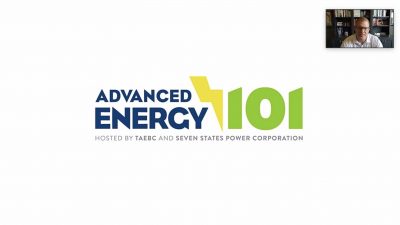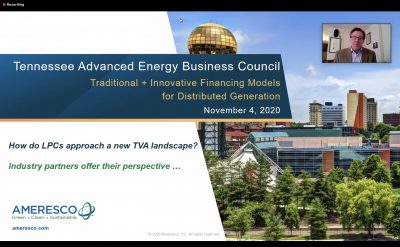
TAEBC and Seven States Power recently wrapped up the virtual Advanced Energy 101 webinar series for local power companies. The three-part series focused on combined heat and power technologies; energy storage and demand response; and financing models for distributed generation.
The first webinar, “Combined Heat and Power,” featured panelists: Isaac Panzarella, Director of the U.S. Department of Energy’s Southeast Combined Heat and Power Technical Assistance Partnership (CHP TAP) located at North Carolina State University; Emily Robertson, Business Development Team Manager, 2G Energy; and Ben Edgar, CEO, White Harvest Energy.
 Panelists spoke about the benefits of combined heat and power (CHP), pathways for utility involvement in CHP projects, types of CHP systems, and who might benefit from this advanced energy technology. Edgar concluded with a case study of White Harvest Energy’s installation of a 4 x 2,000 kW CHP facility at Erlanger Hospital in Chattanooga, Tennessee.
Panelists spoke about the benefits of combined heat and power (CHP), pathways for utility involvement in CHP projects, types of CHP systems, and who might benefit from this advanced energy technology. Edgar concluded with a case study of White Harvest Energy’s installation of a 4 x 2,000 kW CHP facility at Erlanger Hospital in Chattanooga, Tennessee.
During an audience Q&A, Robertson remarked that standard CHP candidates would be “hospitals, universities, wastewater treatment plants, food waste producers” and “manufacturing facilities that have round-the-clock operations.” She noted that mining, renewable natural gas, and grocery store industries are also becoming increasingly interested in CHP. Panzarella added that he is seeing rising interest from hotels, along with state and local government facilities due to a need for grid “resiliency” and to protect critical infrastructure.
 The second webinar in the series, “Energy Storage and Demand Response,” featured panelists: Bradley Greene, Energy Storage Manager, Signal Energy; Clint Wilson, VP, Engineering & Energy Innovations, Seven States Power; and Simon Sandler, Project Engineer, North Carolina Clean Energy Technology Center at North Carolina State University.
The second webinar in the series, “Energy Storage and Demand Response,” featured panelists: Bradley Greene, Energy Storage Manager, Signal Energy; Clint Wilson, VP, Engineering & Energy Innovations, Seven States Power; and Simon Sandler, Project Engineer, North Carolina Clean Energy Technology Center at North Carolina State University.
Panelists provided an overview of energy storage and demand response; emphasized the value of storage for LPCs; discussed relevant energy storage programs and projects; and talked about the benefits of this technology for LPCs. In his presentation, Wilson highlighted successful energy storage systems in the Tennessee Valley, including Raccoon Mountain Pumped Storage.
Answering an audience question about critical factors LPCs should weigh when considering battery storage, Wilson said “all LPCs can participate in battery storage” and reminded attendees it does not fall under TVA’s flexibility provision, where LPCs may generate up to 5 percent of their own energy. Answering a question about the typical lead time for an energy storage system, Greene and Wilson estimate anywhere from eight to 18 months, while Sandler said the time could be 12 to 24 depending on the system.
 The final webinar, “Traditional and Innovative Financing Models for Distributed Generation,” featured panelists: Steve Seifried, Tennessee Solutions Executive, Ameresco; Christian Dick, Sr. Project Developer, Large Scale Distributed Energy Resources, Ameresco; Matt Brown, Vice President, Business Development, Silicon Ranch Corporation; and Virginia A. Williams, Senior Vice President, Project Finance, Silicon Ranch Corporation. Steve Noe, Director, Strategic Energy Solutions, Seven States Power, provided opening and closing remarks.
The final webinar, “Traditional and Innovative Financing Models for Distributed Generation,” featured panelists: Steve Seifried, Tennessee Solutions Executive, Ameresco; Christian Dick, Sr. Project Developer, Large Scale Distributed Energy Resources, Ameresco; Matt Brown, Vice President, Business Development, Silicon Ranch Corporation; and Virginia A. Williams, Senior Vice President, Project Finance, Silicon Ranch Corporation. Steve Noe, Director, Strategic Energy Solutions, Seven States Power, provided opening and closing remarks.
During the webinar, panelists discussed LPC goals and definitions for distributed energy; financing and ownership models; and how to procure the optimal partner and solution. Matt Brown said, “As an LPC, understand your goals and what you as a customer want to achieve. We as an industry want to strategically locate facilities that add resiliency and benefits to all involved.” They spoke about financing tools and structures, along with opportunities and questions LPCs should consider in determining the right financing model for future projects.
“I want to thank TAEBC for their leadership in the Valley and sponsorship of the series,” said Noe in his closing remarks.
Did you miss any of the Advanced Energy 101 webinars? Follow these links to watch “Combined Heat and Power (Passcode: xm73Vk@x),” “Energy Storage and Demand Response (Passcode: s3adDu++),” and “Traditional and Innovative Financing Models for Distributed Generation (Passcode: a3*3Sf?I).”
Want to view the panelists’ presentations? From the first webinar, here are Panzarella, Robertson, and Edgar’s presentations. For the second event, here are Greene, Wilson and Sandler’s presentations. Lastly, here is Seifried’s presentation from the final webinar.
Please visit the TAEBC calendar for future events.
